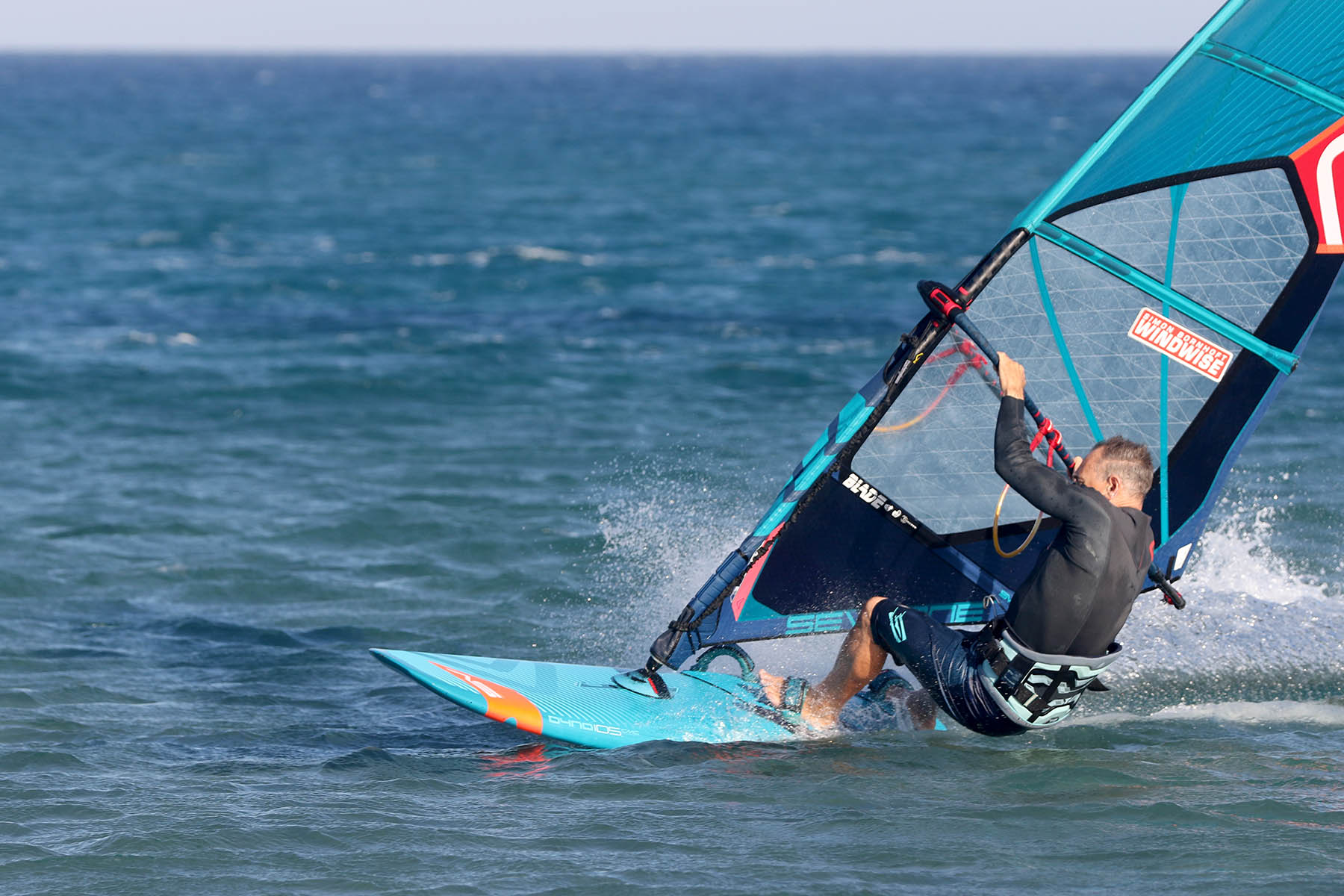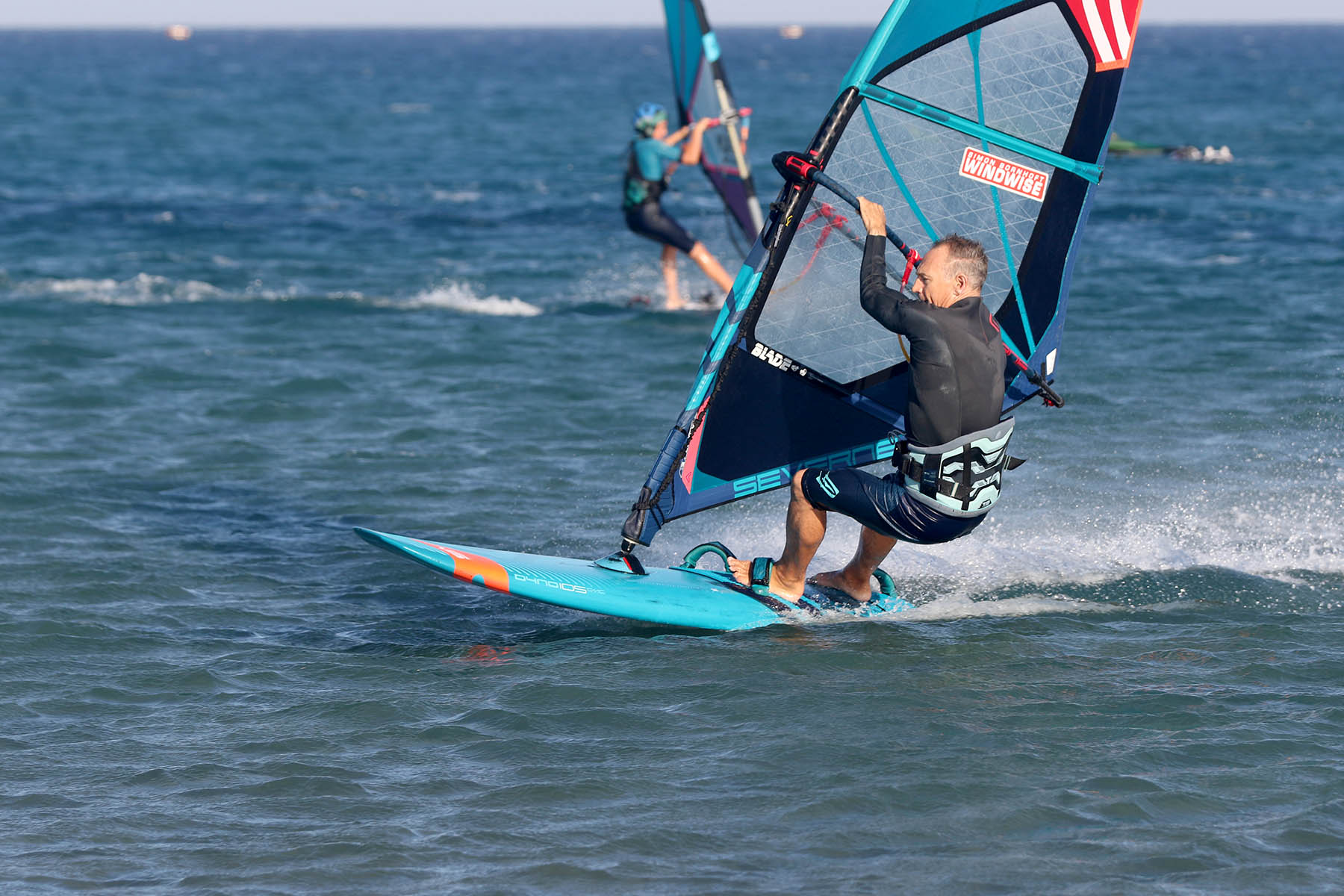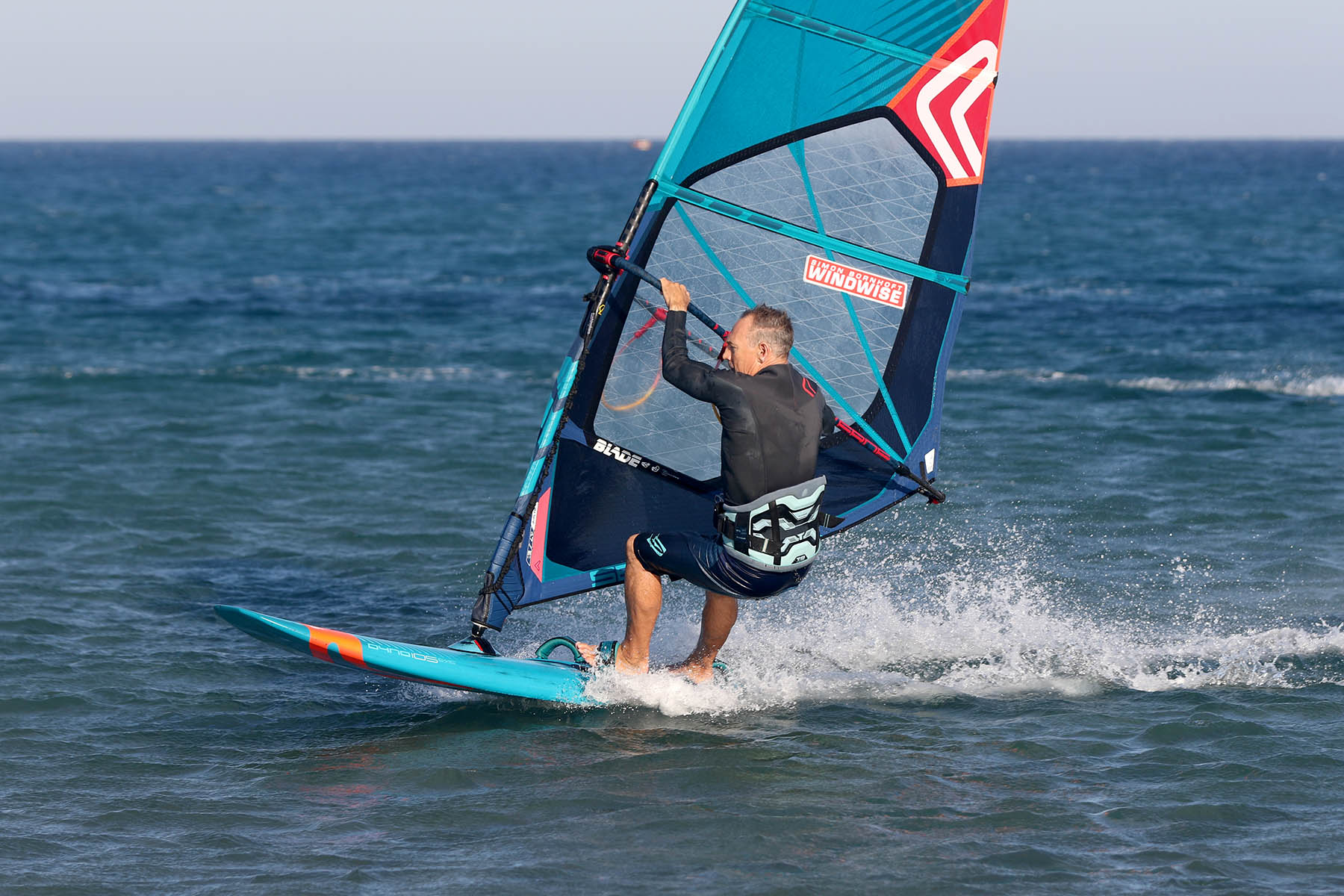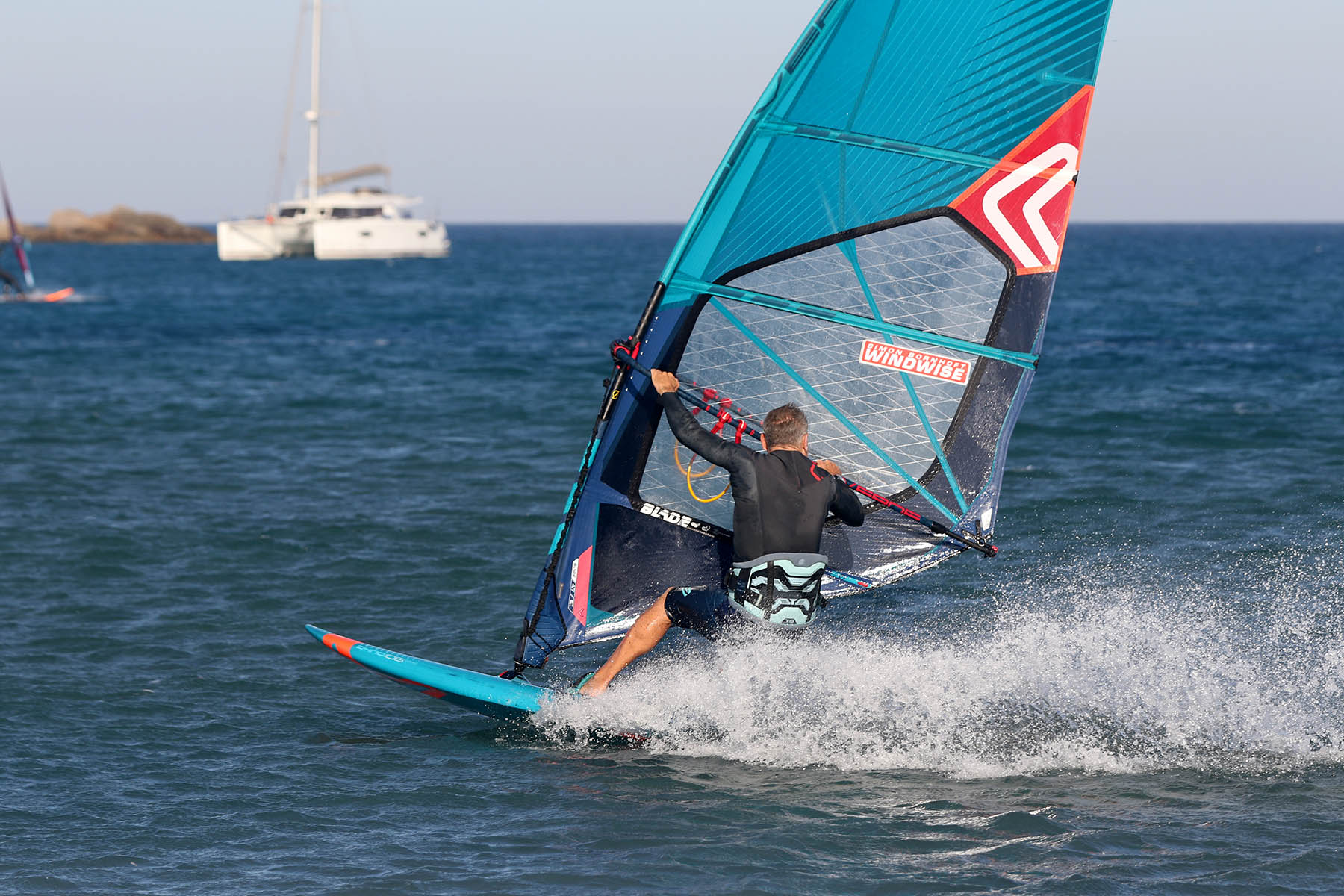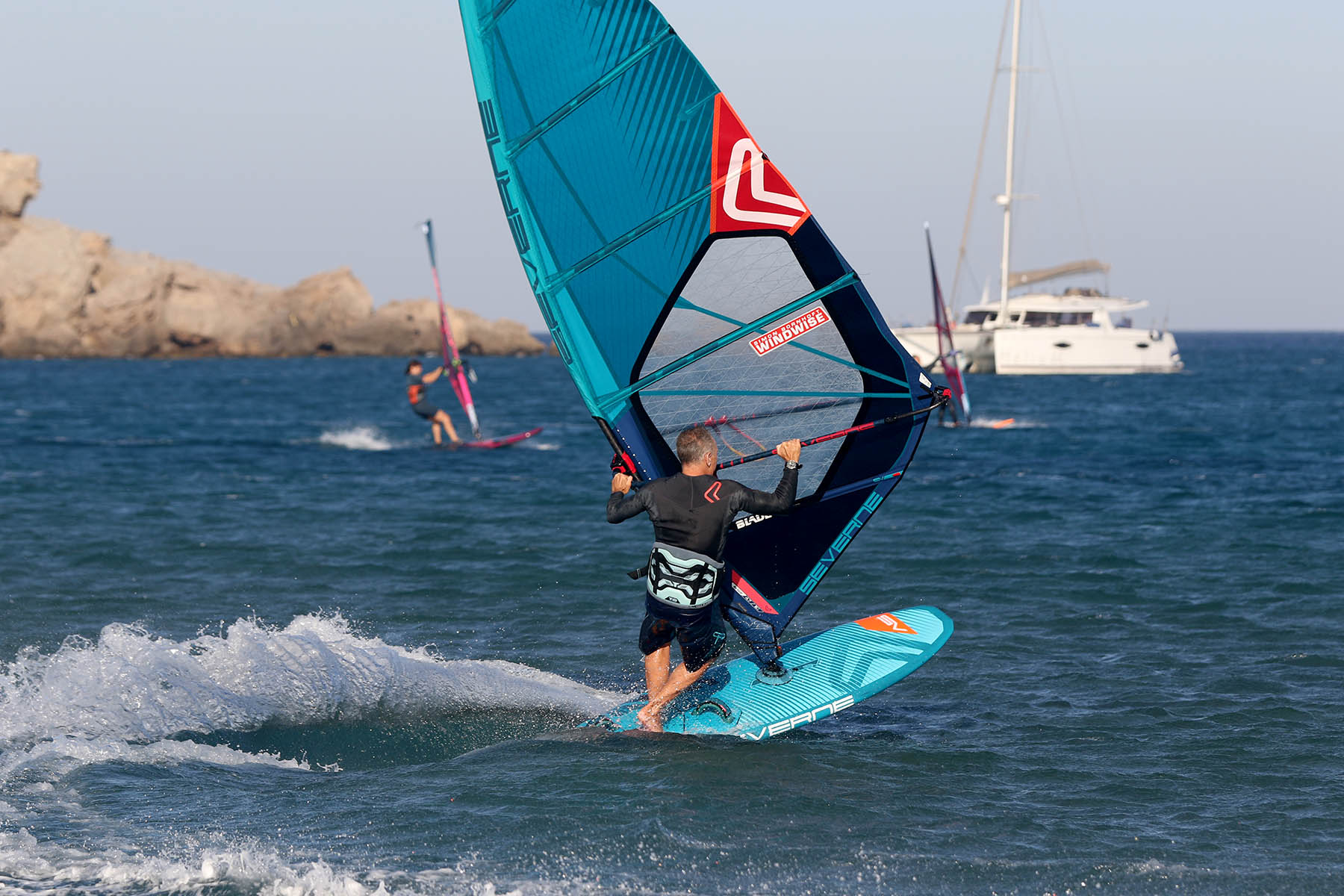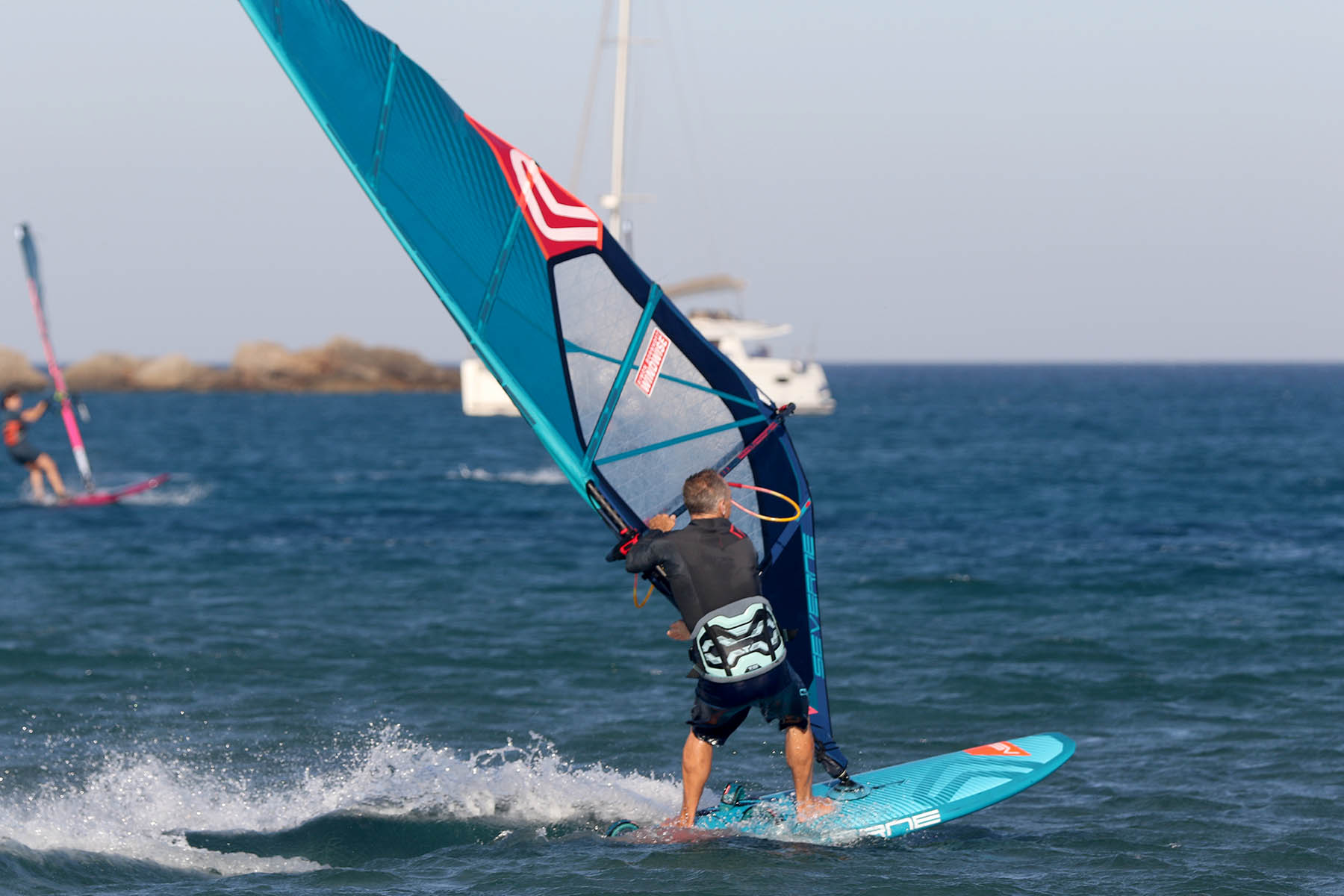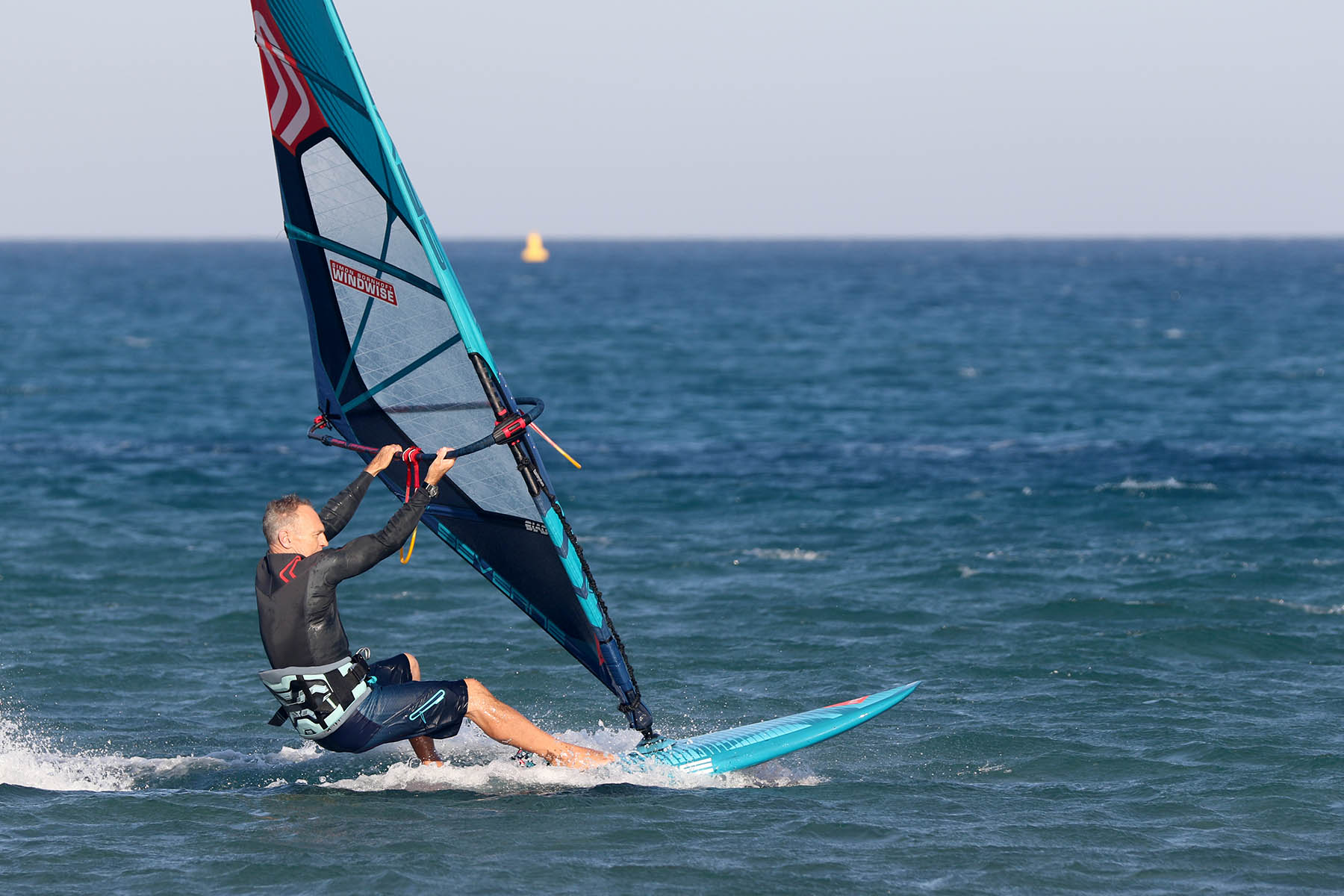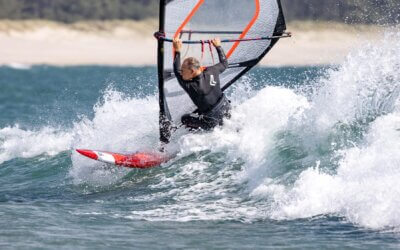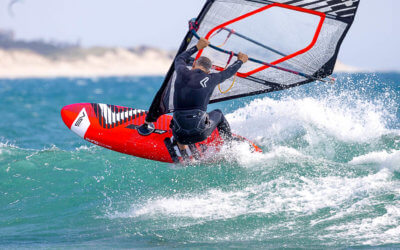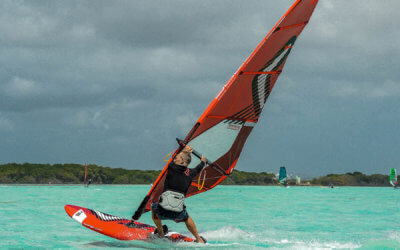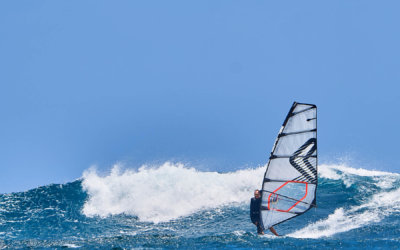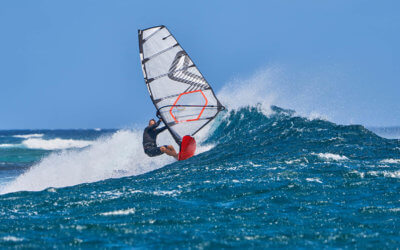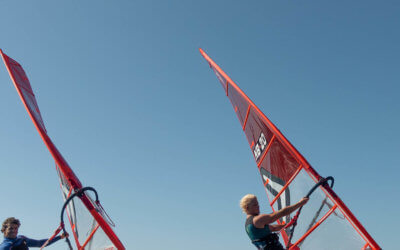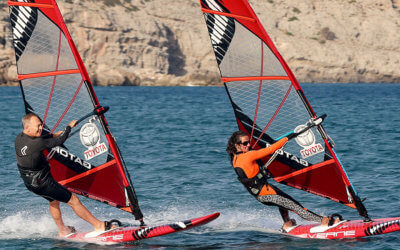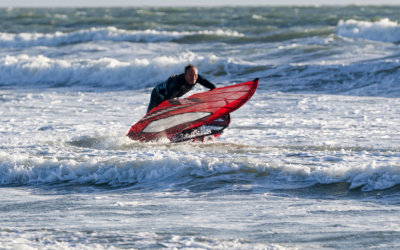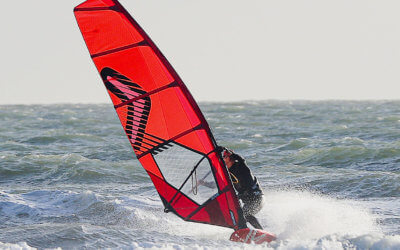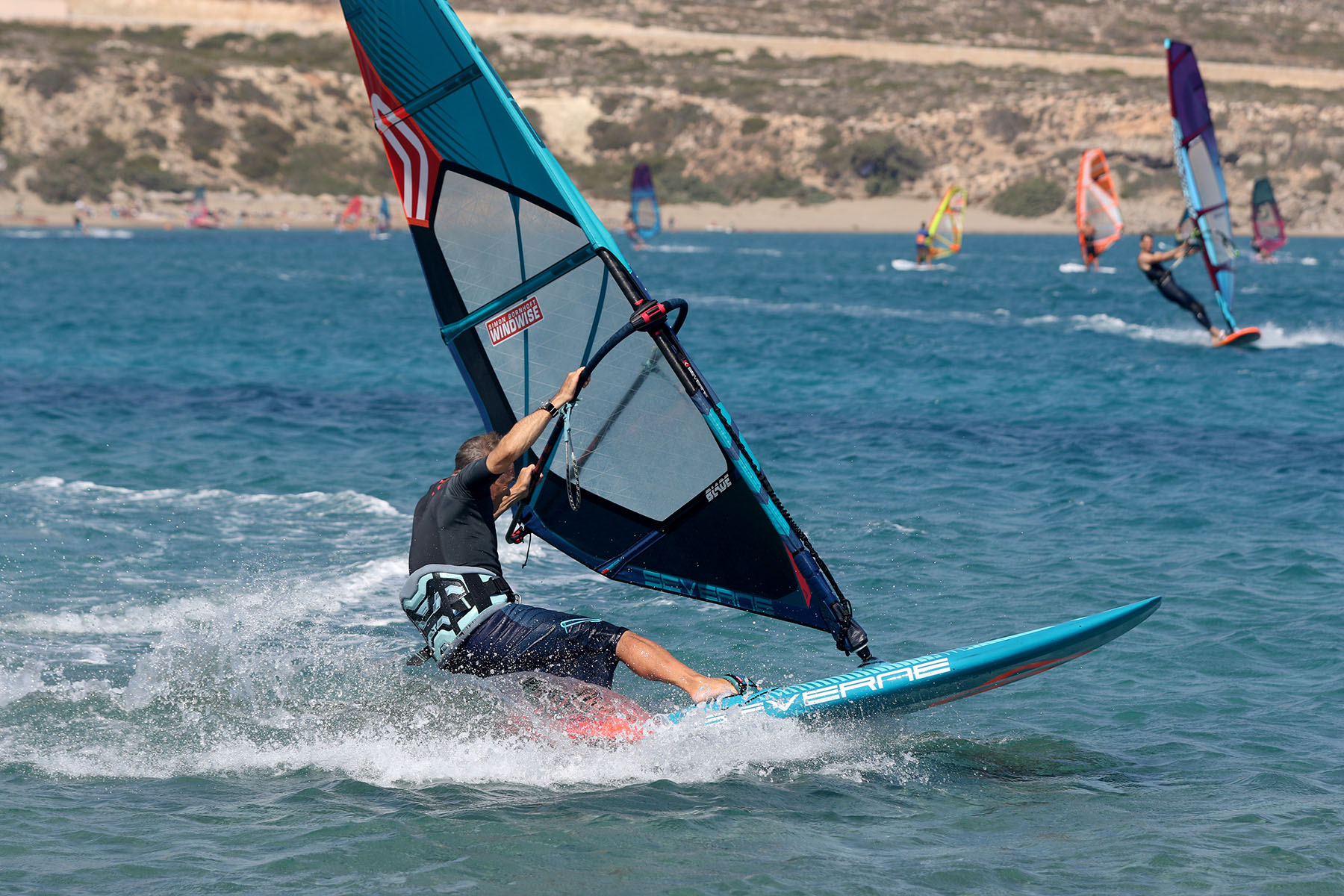
Change the game
Simon Bornhoft looks at how to massively increase your gybing success rate when even just the thought of bearing away sends you and your kit into a total tail spin!
Who’s This For?
Whenever you’re totally over powered and just want to make it round.
The sheer thought of bearing away is hideous.
You lose control of the rig whenever you try to bear away.
You want to improve general board handling, control and wave riding.
Photos: Windwise/KateOcean
Dyno Set Up
Single Fin & Outboard Straps: Freeride blasting and larger rigs.
Thruster & Inboard Straps: Tight cranking gybes, fully powered situations.
Mast Base: Middle to rear of track to help narrow the turning arc.
Dyno Diary: This is when a Dyno really comes into its own, so if you haven’t already, catch a ride on one as they make turns like it’s yours for the taking.
Okay, so you’re cranking along, the rig is bulging with excess power, your knees feel as strong as straw and your arms are about to become elasticated bands the moment you unhook. Plus there’s Jurassic chop, not a second of peace and your gybe is about to resemble an out of control rally car, spitting dirt and barrel rolling into the ditch. What do you do?
Normal gybing protocol suggests taking a fast very broad reach set up (which we’ve covered in this series), however, when the conditions are just mad, this becomes incredibly difficult. The human response is to ‘back off ’, but that usually results in standing up, sheeting out and bearing away ‘just a bit’, all of which makes everything ten times worse. So next time you’re totally maxed out and losing rig control, wise up! Take a different approach with our upwind gybe line, yes UPWIND.
A Different Approach “Spot The Difference”
Same kit, location and wind direction, but two very different gybe lines.
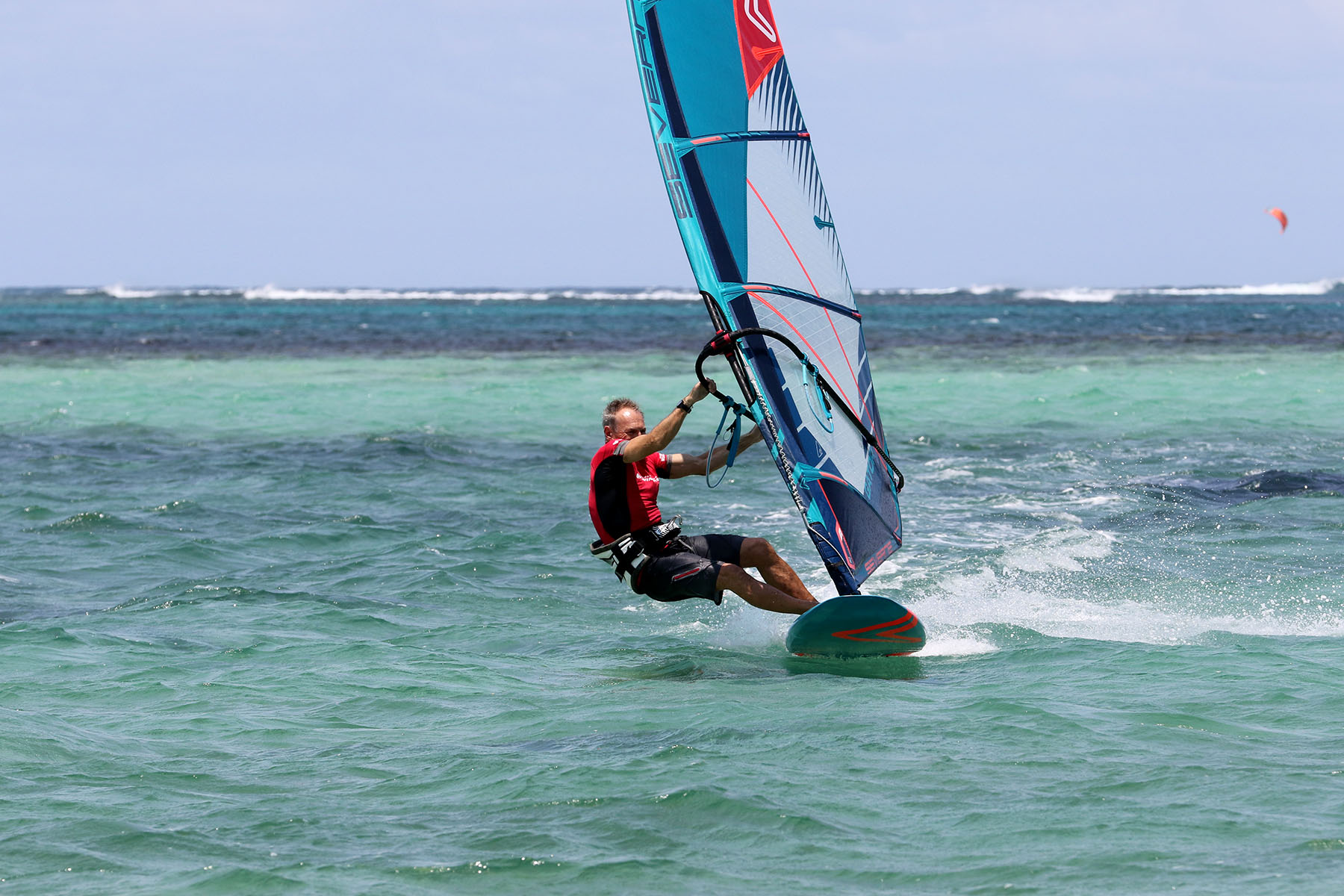
Downwind Gybe Line
As our Windwise series has illustrated, whenever you can, try to take a fast broad reach approach, to set up, cut the corner, depower the rig and increase your gybing exit speed.
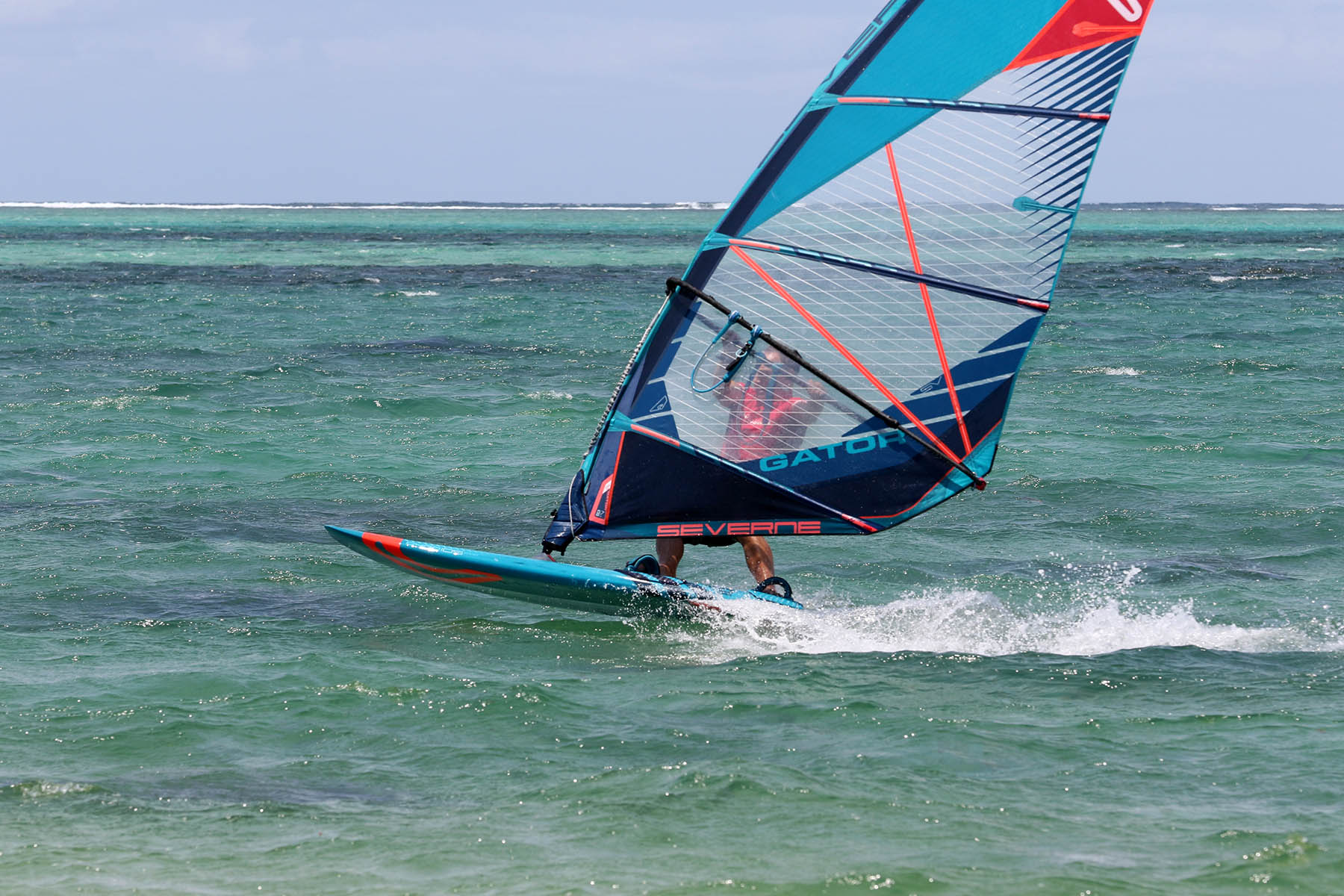
Upwind Gybe Line
However, if you’re massively over powered, facing too much chop and totally maxed out, make the executive decision to take an upwind set up line to prepare for a really tight turn. Here’s why an upwind set up works…
- Reduces board speed, fear and gives you more time to think and gain control.
- MOST IMPORTANTLY it enables you to crucially sheet the rig IN on the tight bear away.
- Heading upwind first enables you to commit and turn tighter without the board running away from you downwind.
Here’s how YOU can do it too!
Windwise Warrior Ethos
As ever accentuate the core basics…
LOOK through the turn to where you want to go.
LEAN the whole body in ‘Warrior’ over a heavily flexed knee.
LEVER the rig the ‘opposite’ way to counter balance.
Windwise Gybing Touch Points From GybeWise Part 1-4.
Entry: The clew hand slides down the boom.
Carving: The toes on the inside rail, next to rear strap.
Rig Rotator: Mast hand slides up to the boom clamp to ‘hinge’ during the rig rotation.
WiseWords
Carve upwind further than you possibly thought!
Pull down harder on the boom than ever before!
Prepare to carve super hard and tight to prevent the board running away downwind.
** I have deliberately illustrated the sequence on flat water, so you can see the different lines, but this is an exact replica of what you’d do in massive chop, confused water states or controlling excess speed **
UPWIND GYBE LINE
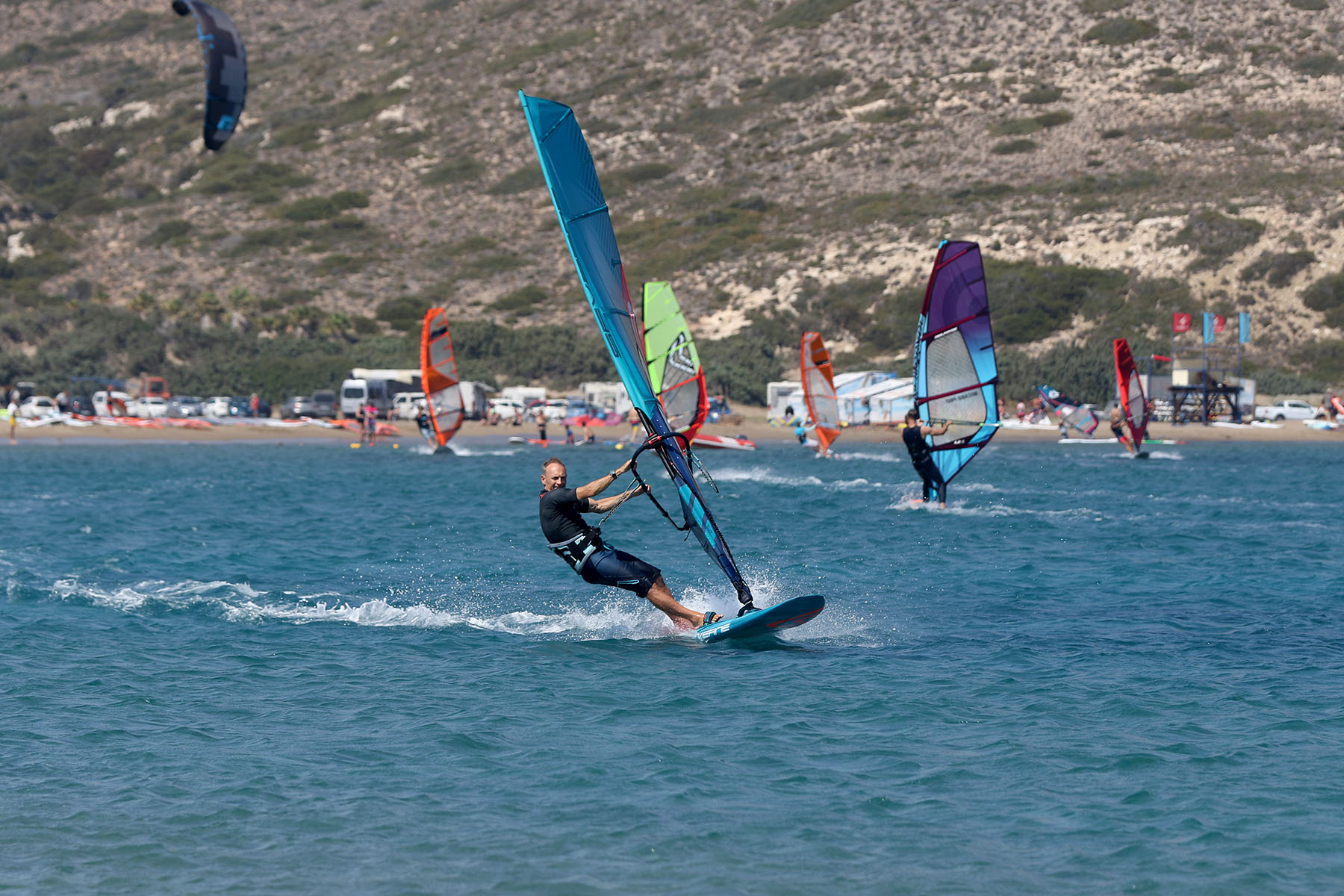
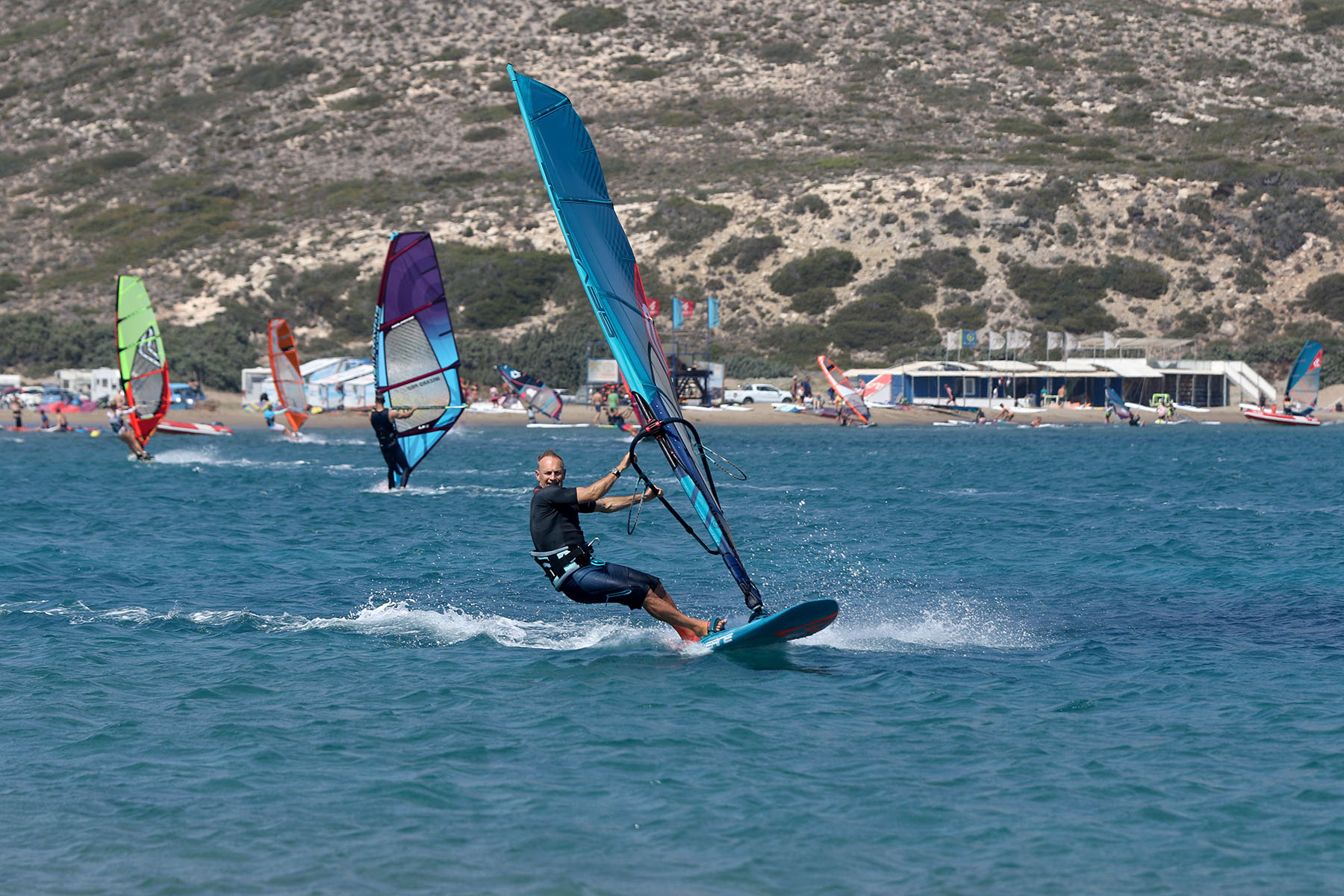
Head Upwind
Counterintuitively head UPWIND, like going into a tack, by heavily weighting the heels and sinking the hips down. Initially, this is done in the harness, but as the board starts to slow, set up for your ‘upwind carve gybe’ by going through your wisest gybe entry process;
- Sink low, slide the backhand down the boom, pull down extra hard to unhook.
- Stay low to slide the back foot out of the strap onto the windward rail – wait a second.
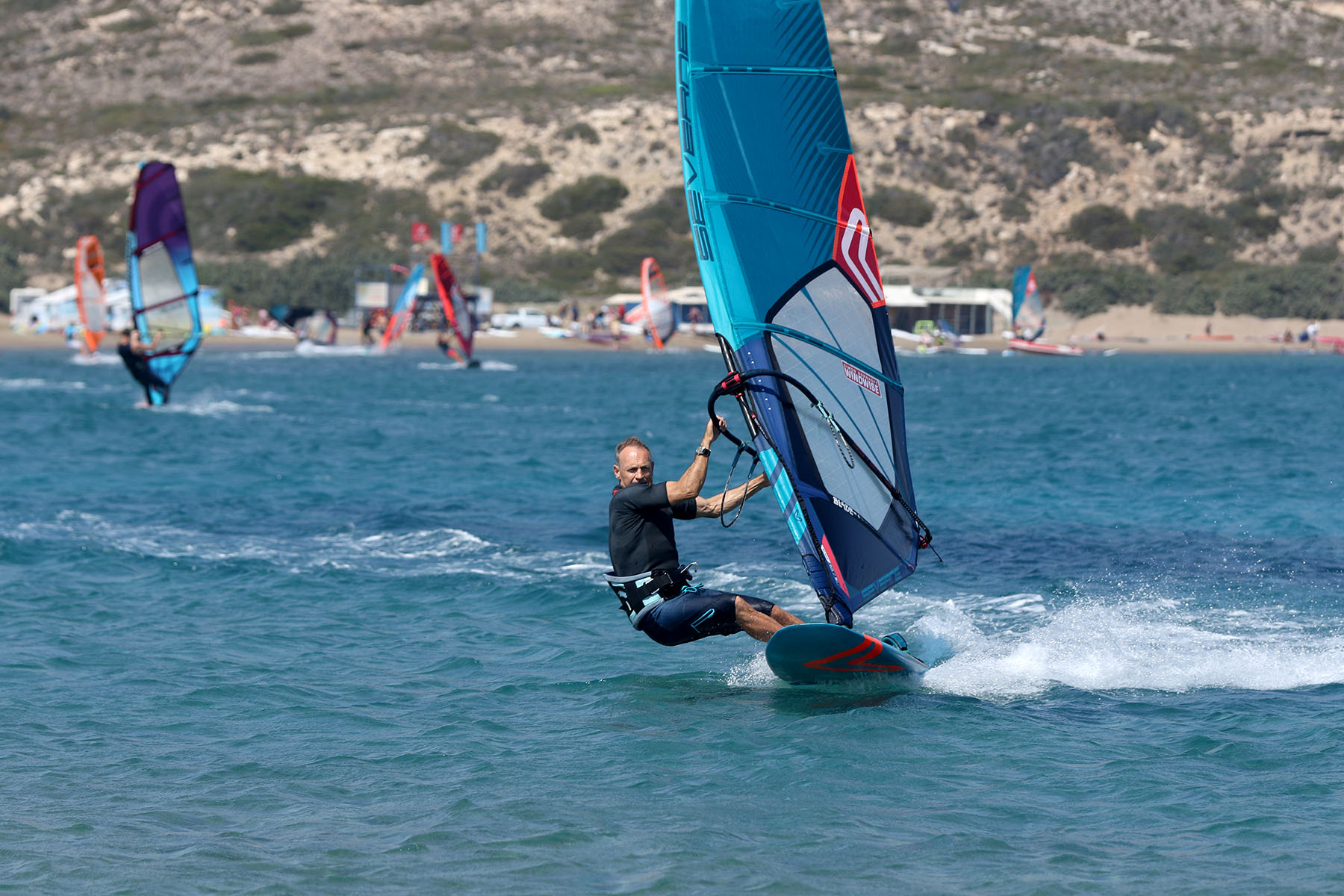
Warrior Upwind
Lean the body forward in Warrior, looking and leaning upwind over a heavily flexed knee. If you have to, sail ugly, by pulling in and down on the mast arm to lean forward and drive pressure down through the mast base.
- Look for the flattest piece of water or trough of a wave.
- Keep the body outboard as you slide your back foot across to the leeward side.
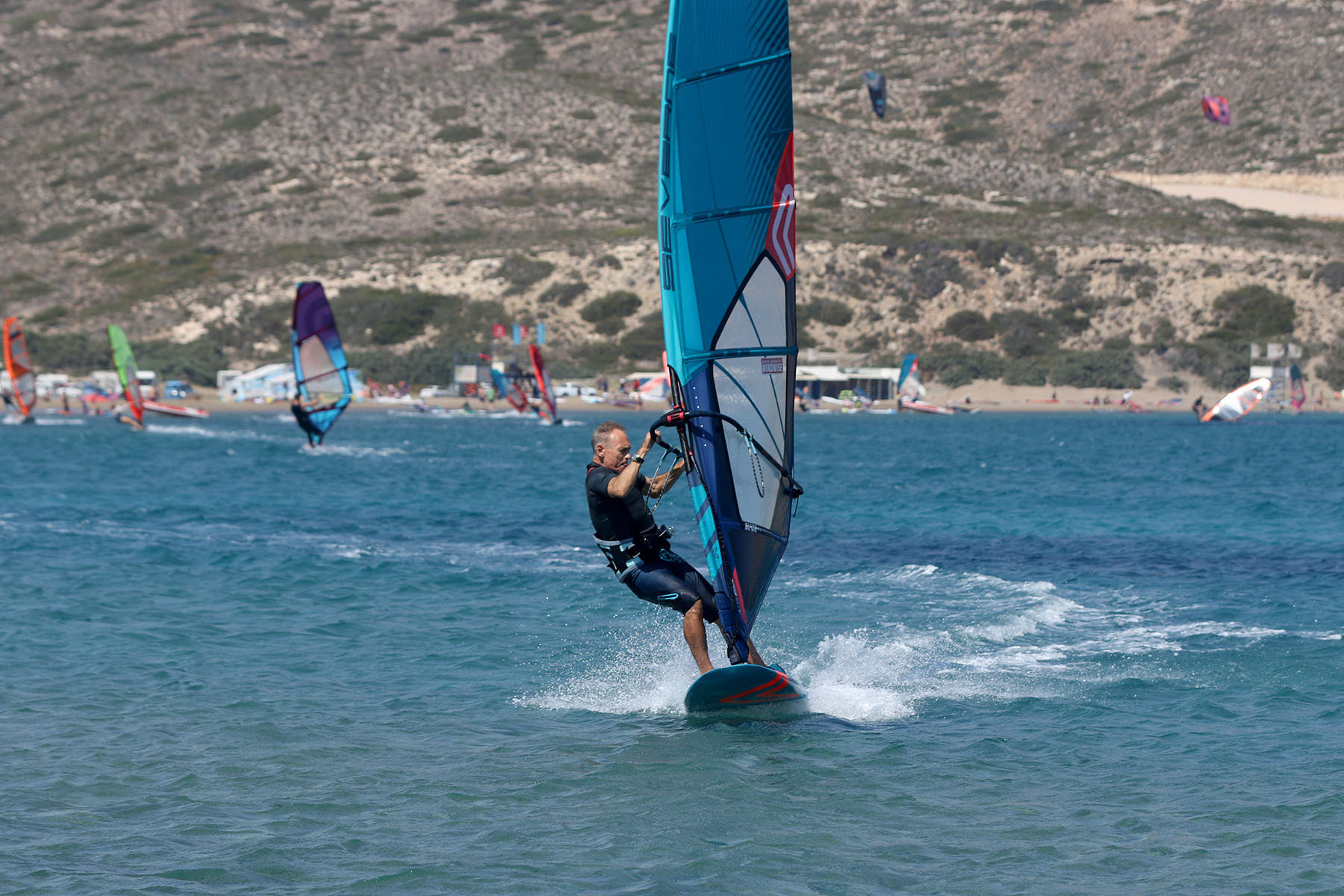
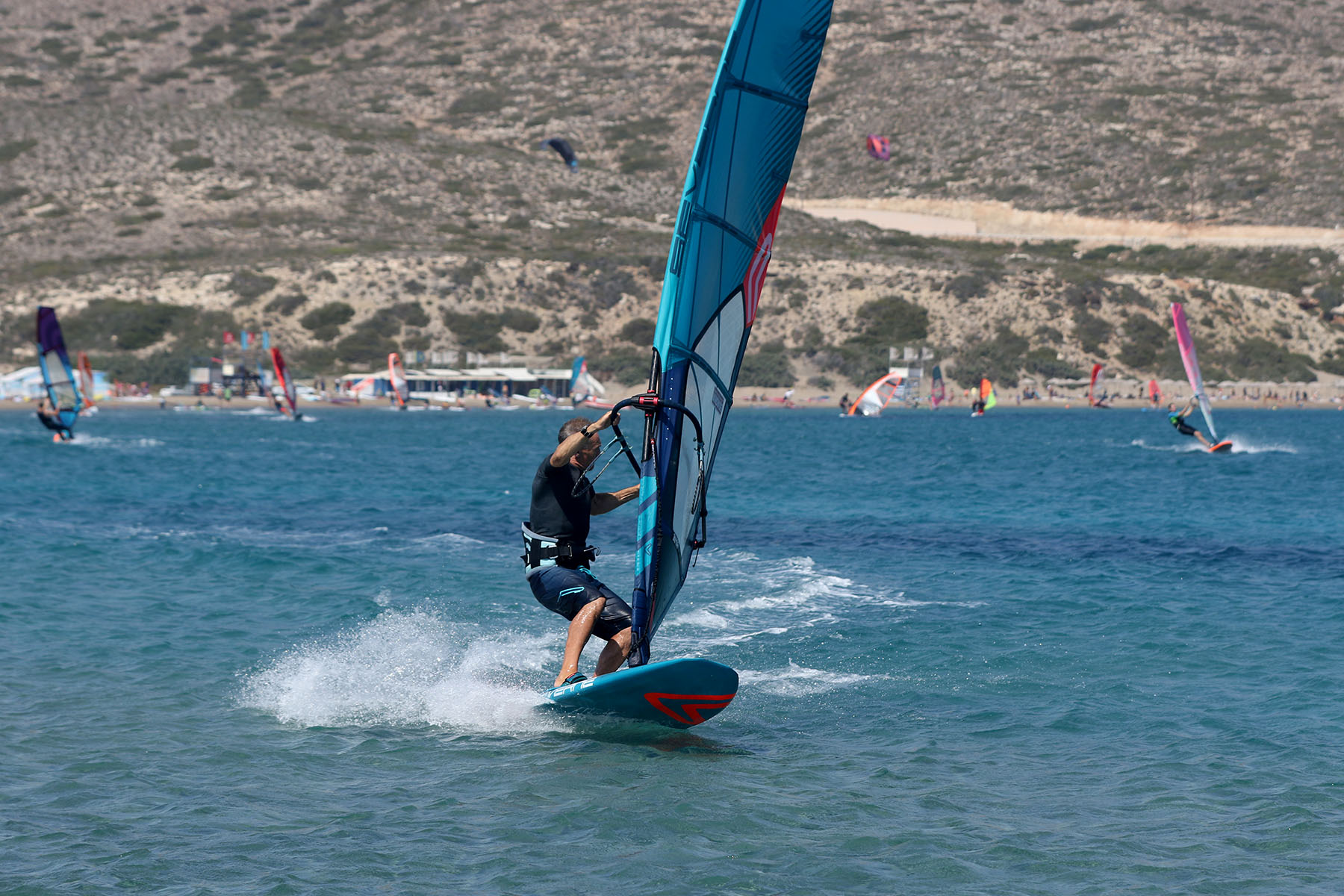
Carve Hard Early
To initiate the carve, come across onto the inside foot – so now Warrior into the turn! Sheeting in and down super hard on the boom with the clew hand. Keeping the mast hand forward as much as possible will create more control and reduce the chances of the board doing a wheelie!
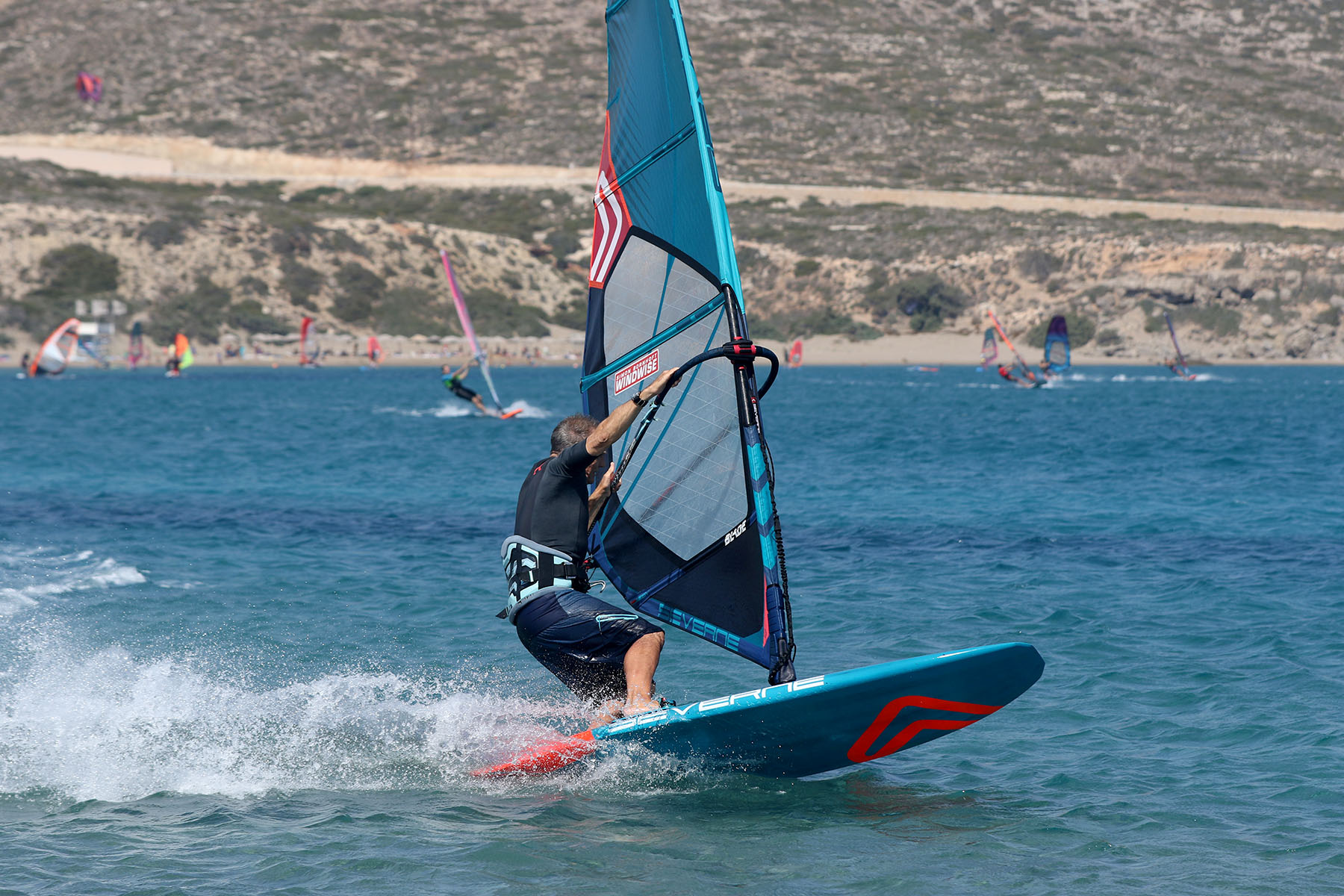
The Power Surge
Anticipate and control the surge of power, by accentuating your Warrior ethos, look and lean over a heavily flexed knee, keeping the hips low and pull in and down ridiculously hard on the clew hand. To counter balance and get the board to turn, extended the mast hand in the opposite direction to the hips dropping into the turn.
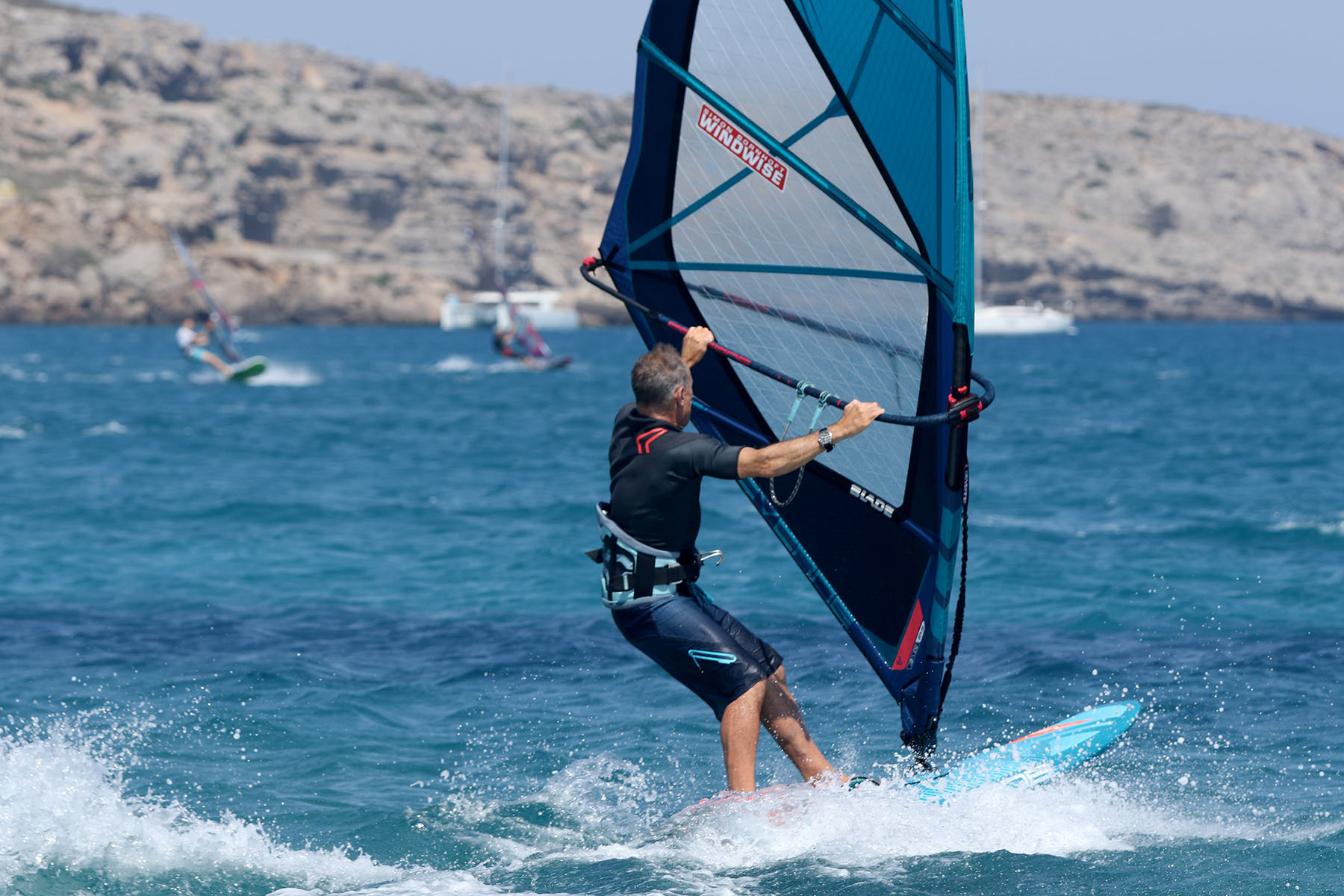
Shift & Switch The Feet
Switch the feet dead downwind, pulling down on that boom impressively hard! Be the boss!
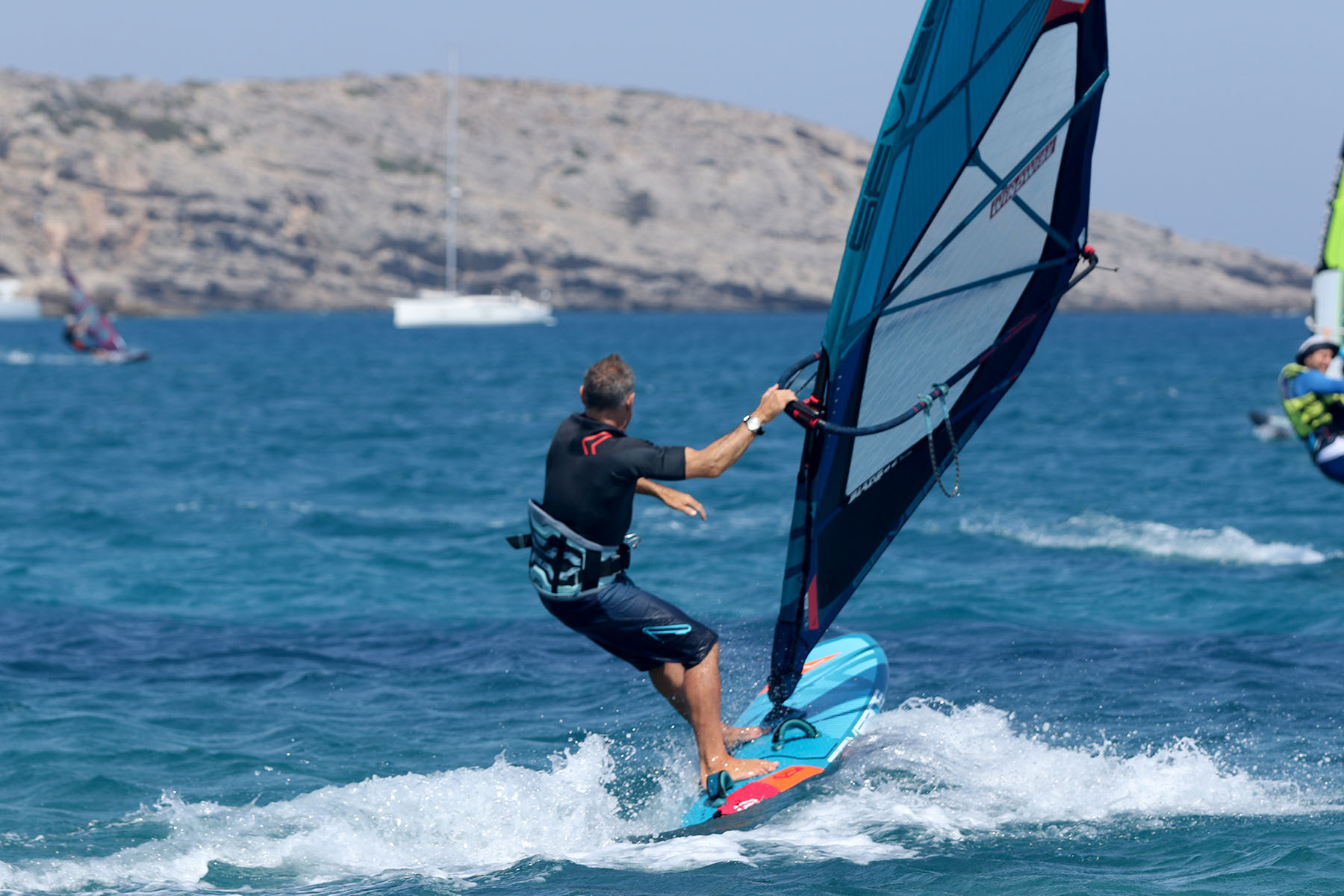
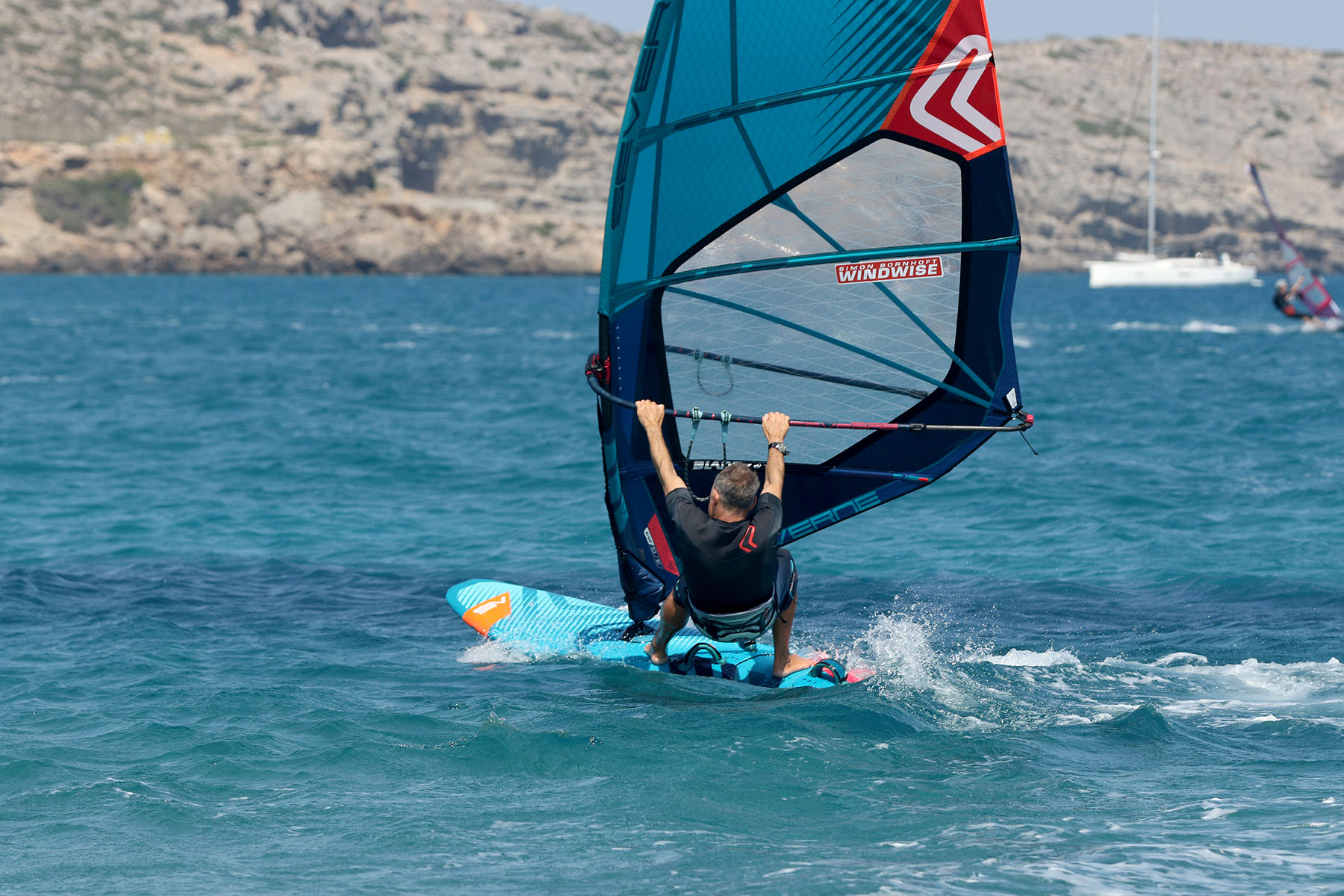
Broad Reach Exit
‘Hinge’ the mast hand up to the mast, to control the rig rotation on a very broad reach, this stops the rig being pulled out of your hands and gives you time to get low and drive the board back onto the plane.
Ramp It Up
Check out this sequence to see just how much you can carve upwind to make it much easier to turn tightly and still plane out.
None The Wiser
Q. The board just slows down and stops.
A. Lean forward more in Warrior to keep the nose down.
Q. The board runs away from me and I lose the clew completely.
A. Usually means you didn’t go upwind enough first and or drop your body down sufficiently to help pull in and down on the clew hand.
Q. I find the board does a wheelie and jumps out of the water?
A. You’re leaning back with straight legs and pulling the rig with you.
Simon Says…
When I run this past my clients, NOBODY grasps quite how much you can and should head upwind before you gybe. But in time, they learn to love it, realise how low you can go to really tighten the acuteness of their gybing arcs, creating calm and control even on those maxed out crazy days.
Next month we’ll look at some very common gybe faults for you to you self diagnose your own sessions. In the meantime, if you have any windsurfing technique questions or want to know how to get the best out of your Dyno, drop me an email info@windwise.net!
Want to improve your windsurfing and try some Severne gear?
Join a skill enhancing Windwise session to get the most out of your time on the water!
Your progression and a great time guaranteed!
2021 Windwise Winds Of The World Tour
Freeride + Freewave + FoilWise
Tenerife / Bonaire / Alacati / Prasonisi / Mauritius
info@windwise.net
Copyright: Simon Bornhoft Windwise 2021
More DYNO guides
DYNO BOARD SETUP WITH SIMON BORNHOFT PART 19 – HOW TO PREPARE FOR WAVES PART 4
Push it, drive it and accentuate! When conditions are tricky or you’re new to a wave environment, it’s important to stick to a plan and ‘try’ to massively exaggerate everything, no matter what you’re faced with. So, what better than to check out some real examples of Severne rider and Windwise coach Simon Bornhoft’s clients riding the Dyno and putting into practice some of the skills we’ve covered in our recent wave series.
DYNO BOARD SETUP WITH SIMON BORNHOFT PART 18 – HOW TO PREPARE FOR WAVES PART 3
Have you been inspired by the recent PWA Pozo Wave event? Well, here’s what YOU can do to get yourself into waves. Simon Bornhoft continues his Windwise series on how to fully develop your windsurfing skills, maximize your time on the Severne Dyno and, for this issue, continue your mission in the waves. So whether you’re new to freewave/wave windsurfing or polishing up your existing wave skills, this will give you a focus and purpose for your next sessions.
Dyno board setup with Simon Bornhoft part 17 – How to prepare for waves part 2
Severne Team Rider and International coach Simon Bornhoft continues his Windwise series on how best to develop your windsurfing skills. In this part, Simon goes deeper into how to prepare for your next wave session, even though you might not have access to waves.
DYNO BOARD SETUP WITH SIMON BORNHOFT PART 16 – HOW TO PREPARE FOR WAVES
Severne Team Rider and International coach Simon Bornhoft has helped thousands of recreational sailors to get into or improve their wave sailing skills on his Windwise courses. So if you’re on the cusp of venturing into any wave environment here are some skills that can be learnt on flat water and transferred into the rough stuff. Follow these wise words to increase your enjoyment and success rate in 2022!
Everything you need to know about your harness lines – hang In There Part 3 Wave & Freestyle
Windwise coach and Severne Team Rider, Simon Bornhoft, continues his ‘Hang In There’ harness line series looking at different disciplines and sailing styles. For this issue, we shift the focus and harness line positions for the Freewave, Wave & Freestyle playgrounds. So whether you’re a weekend wave warrior or looking to fine tune like a pro, wise up and read on.
Everything you need to know about your harness lines – Hang In There Part 2 Slalom & Freeride
Windwise coach and Severne Team Rider, Simon Bornhoft, continues his quest to help you get the most out of your precious time on the water and your kit. For this feature we continue our ‘Hang In There’ harness line series, looking at different disciplines and styles in windsurfing and draw on the speedy talents of Team Severne top riders.
DYNO BOARD SETUP WITH SIMON BORNHOFT PART 15 – Going shorter
Whether you’re moving into planing conditions for the first time or moving down in board volume, Simon Bornhoft offers some wise words on how to make smaller beautiful.
Dyno board setup with SImon Bornhoft part 14 – carving downwind 360
For this issue, we get into some serious carving with a downwind 360. Just trying them is a great way to improve your gybing ability, board handling and feel that Dyno carving sensation.
Dyno board setup with Simon Bornhoft part 13 – Gybe variations
Severne rider and coach Simon Bornhoft helps you expand your gybing range with a classic ‘Strap-to-Strap’ wave style gybe to make you and your Severne Dyno board feel like wave masters.

